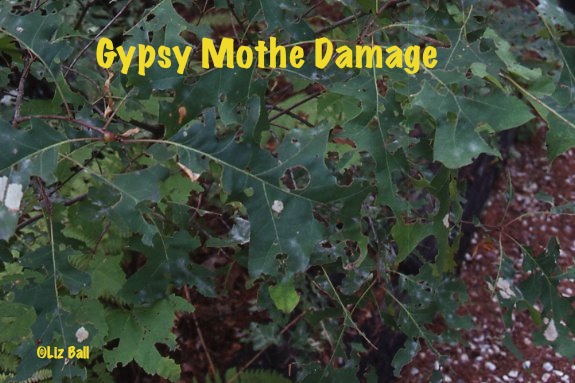 Symptoms of Gypsy Moth
Symptoms of Gypsy Moth
One easy clue to the gypsy moth’s presence is the fuzzy, oval shaped egg masses that the moths deposit in the fall on tree trunks, usually in protected spots such as bark flaps, crevices, and holes. Look around--you may also find the eggs pasted on leaves, on the ground, on lawn furniture, stone walls, woodpiles, fences, roof overhangs, walls, and even on cars and trailers. Later, if the infestation is heavy, the number of gypsy moth caterpillars munching foliage is so great that their waste pellets (feces) fall to the ground, creating a sound like a gentle spring rain. This rather revolting indicator tells you that complete tree defoliation is possible. Most trees that are strong and healthy will survive a complete defoliation if it occurs for just one year. However, defoliation over a 2 or 3 year period can kill even a healthy tree. Evergreens are at special risk at such times.
It’s possible to monitor your yard for the presence of the adult moths with special traps, which use a synthetic sex attractant to trap moths and prevent them from mating. Available at garden centers, these traps may help you locate gypsy moths, estimate their abundance, and help plan controls. However, we do not recommend using these traps. They catch moths, but not nearly enough to influence the severity of the caterpillar attack next year.
Plants Affected
The following trees and shrubs are most vulnerable to attacks by gypsy moth caterpillars of all ages:
Alder (Alnus)
Apple (Malus)
Basswood (Tilia)
Bigtooth Aspen (Populus grandidentata)
Boxelder (Acer negundo)
Gray Birch (Betula populifolia)
Hawthorn (Crataegus)
Hazelnut (Corylus)
Hop Hornbeam (Ostrya)
Larch (Larix)
Linden (Tilia)
Lombardy Poplar (Populus nigra cv. ’Italica’)
Oaks (Quercus) -- all species
Paper Birch (Betula papyrifera)
Quaking Aspen (Populus tremuloides var. aurea)
River Birch (Betula nigra)
Roses (Rosa)
Serviceberry (Amelanchier)
Sumac (Rhus) - all species
Sweetgum (Liquidambar Styraciflua)
Willow (Salix)
Witch Hazel (Hamamelis).
The following trees and shrubs may be eaten by older caterpillars, but may not be seriously harmed by defoliation:
American Beech (Fagus grandifolia)
American Elm (Ulmus americana)
Black Birch (Betula lenta)
Black Cherry (Prunus serotina)
Blackgum or Tupelo (Nyssa)
Black Walnut (Juglans nigra)
Blueberries (Vaccinium)
Butternut (Juglans cinerea)
Chestnut (Castanea)
Chokecherry (Prunus virginiana)
Cucumber Tree (Magnolia)
Eastern Cottonwood (Populus deltoides)
Eastern Hemlock (Tsuga canadensis)
Hackberry (Celtis)
Hemlock (Tsuga)
Hickory (Carya) -- all species
Norway Maple (Acer platanoides)
Ohio Buckeye (Aesculus glabra)
Pawpaw (Asimina triloba)
Pear (Pyrus)
Persimmon (Diospyros)
Pin Cherry (Prunus pensylvanica)
Pines (Pinus) -- all species
Redbud (Cercis)
Red Maple (Acer rubrum)
Sassafras (Sassafras albidum)
Silver Maple (Acer saccharinum)
Silver Poplar (Populus alba)
Slippery Elm (Ulmus rubra)
Sourwood (Oxydendrum arboreum)
Spruce (Abies) -- all species
Sugar Maple (Acer saccharum)
Sweet Cherry (Prunus avium)
Sweetfern (Comptonia peregrina)
Yellow Birch (Betula lutea)
Yellow Buckeye (Aesculus octandra).
The following trees and shrubs are usually avoided by gypsy moths:
American Holly (Ilex opaca)
Arborvitae (Thuja)
Ash (Fraxinus) -- all species
Azalea -- all species
Bald Cypress (Taxodium distichum)
Balsam Fir (Abies balsamea)
Black Locust (Robinia pseudoacacia)
Catalpa
Dogwood (Cornus)
Eastern Red Cedar (Juniperus virginiana)
Elderberry (Sambucus)
Fraser Fir (Abies Fraseri) xx start here
Grape (Vitis)
Greenbrier (Smilax)
Honey Locust (Gleditsia)
Horsechestnut (Aesculus Hippocastanum)
Juniper (Juniperus)
Kentucky Coffee Tree (Gymnocladus dioica)
Mountain Laurel (Kalmia latifolia)
Mountain Maple (Acer spicatum)
Mulberry (Morus)
Raspberries (Rubus)
Rhododendron
Sarsparilla (Aralia nudicaulis)
Sheep Laurel (Kalmia angustifolia)
Spicebush (Lindera benzoin)
Striped Maple (Acer pensylvanicum)
Sycamore (Platanus occidentalis)
Tulip Tree (Liriodendron tulipifera)
Viburnum -- all species.

